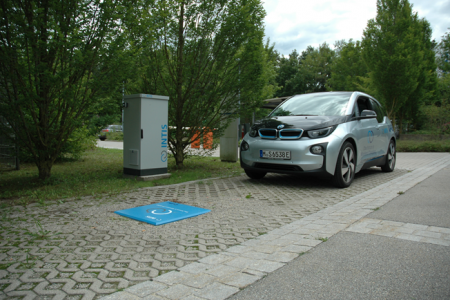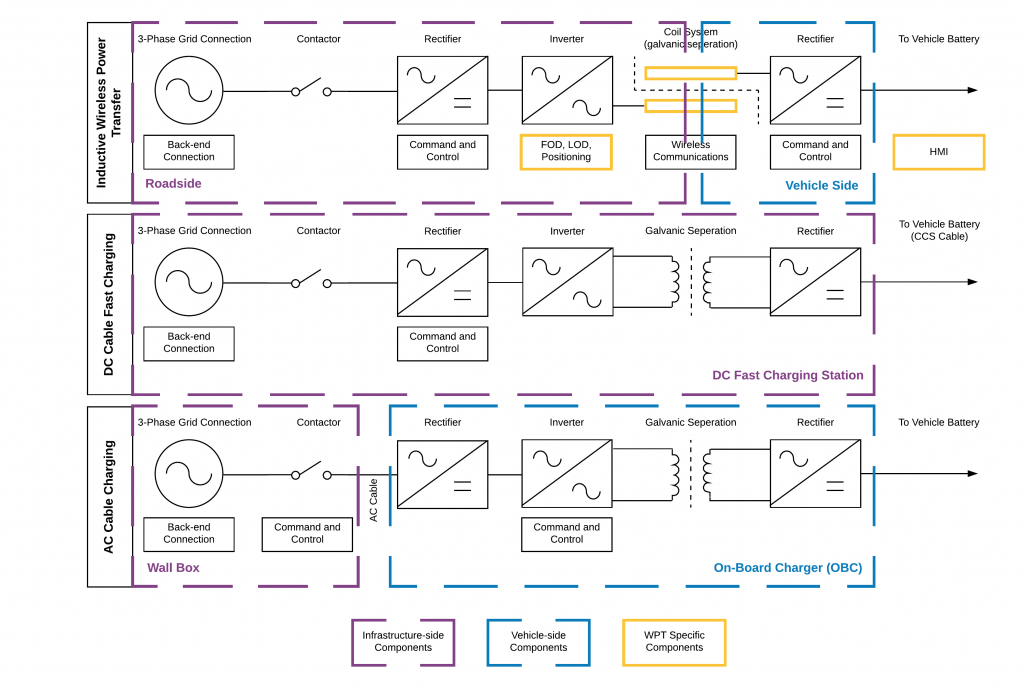Wireless inductive charging, also known as Wireless Power Transfer (WPT) or inductive energy transfer, has been in the news quite a lot recently and it’s easy to get the impression that it is a new technology which is still in development. In fact, inductive energy transfer has been in use for decades in industry and for almost two decades in public areas. Today, WPT technology is available with power transfer levels and efficiency comparable to DC fast charging.
In the 2000’s, a 500 kW WPT system for the TR-09 TransRapid Maglev train was implemented at the TransRapid Test Centre (TVE) in Germany. Systems integration and testing of the technology was carried out by the operators of the TVE, IABG (Industrieanlagen Betriebsgesellschaft mbH) a high-tech enterprise based in Ottobrunn near Munich. In 2011 the TVE business unit, personnel and WPT development where spun off into the IABG subsidiary INTIS (Integrated Infrastructure Solutions). With a focus on developing infrastructure solutions for future transport systems and sustainable energy sources and delivering inductive charging technology to the market, the company’s strategy is to combine and optimise systems and technology from across the whole IABG family of companies.

Richard Gould (M.Eng – Systems Engineering) and Business Development and Project Manager for INTIS explains WPT technology
INTIS has made use of its 15 years of WPT experience, extensive facilities and the backing of IABG group to develop technology for use while stationary or driving. In 2013 it demonstrated the technical feasibility of transferring energy on the move, providing an 18m electric bus and EV sports car with up to 60 kW of power while driving at up to 50 km/h with a DC-DC efficiency of over 90% .
Subsequently, it developed stationary charging technology with charging powers of up to 50 kW for small vehicles, such as autonomous industrial vehicles, taxis and vans, with a complete system efficiency of above 90% (from AC grid to vehicle battery). For larger vehicles such as buses, higher powers are available by combining 50 kW modules, with charging powers as high as 250 kW possible for heavy vehicles.
We have been at the forefront of WPT developments since the beginning, which means we have had to create a complete WPT system and components from scratch, from the power electronics, to the control and communications systems, to the coil system. This gives us a deep insight into the complete WPT system and sub-systems”, he explains
Inductive energy transfer systems operate like a transformer with an airgap between the coils. When an alternating electric current passes through a road-side coil, this generates an alternating magnetic field. When this magnetic field passes through a coil attached to the vehicle, a voltage is induced with a subsequent flow of current. Since the voltage is only induced when the magnetic field changes, a rapidly alternating current is required. WPT system AC operating frequencies between 20 and 90 kHz are common.
In a direct high-level comparison, however, it may be surprising how similar WPT is to other types of chargers (e.g. power electronics, control systems, interfaces), although components need to be optimised to the application. This also means that the efficiency and costs of the different technologies, WPT and cable charging, must also be similar.
Additional peripheral components, such as Foreign Object Detection (FOD), Living Object Detection (LOD), positioning systems and a human machine interface (HMI) for the driver, are what set WPT systems apart from their cable counterparts. Additional interfaces specific to WPT are the installation of the charging plate in the road, the installation of the pickup plate underneath the vehicle and the HMI to allow charging control and show positioning information for the user. Figure 1 provides an overview of WPT and cable chargers for comparison.

Real World Conditions
Gould went on to say “Our demonstration systems having been in operation with customers in real-world conditions for the past 3 years. This has enabled us to gain some key information about how the technology performs when used in earnest. Every time we exhibit at a trade fair, such as the recent IAA in Frankfurt, we get asked many of the same questions. In preparation for eMove360° we would like to move the discussion forward, so here are some answers to those frequently asked questions, including some results from 3 years of real-world WPT use”.
The Efficiency
It may already be clear why WPT has a similar efficiency to other charging types, at least if the full grid-side AC to vehicle battery DC path is considered (something that is often forgotten for AC charging with an on-board charger – OBC). The coil system – the key component of any inductive energy transfer technology – (including compensation) is the only additional power component, so any significant additional losses are incurred there. Since the airgap itself is practically lossless (unless energy is taken out of the magnetic field) losses in the coil system are, in practice, limited to resistance losses, skin effect losses (due to the high AC frequency) and proximity effect losses (generated in the litz cable often used for the coils). In addition, some losses occur in the ferrite material used to focus the magnetic field within the area of the two charging plates.
INTIS undertook a one to one comparison of a 50 kW CCS charging system and a 50 kW WPT system at the beginning of 2019, using the same power electronics components and control system in both cases . End to end (AC grid to DC battery intermediate circuit) was measured at 94% for the CCS charger and 92% for the WPT system. The 2%-point difference incurred in the WPT coil system is well within the range of efficiency that different DC fast charging systems incur due to various architectures, for example when using different power electronics topologies (e.g. power control with or without a DC-DC converter) and components (e.g. IGBTs or SiC MOSFETs).

It is also clear that future R&D to improve WPT efficiency relative to cable charging will be focused on the coil system.
Technology Cost
Leaving technology costs aside (e.g. IP licence costs, development costs, etc.) there is, again, very little difference between components in a WPT system and in a cable charging system. In short, the differences are:
- The coil system,
- the coil system interfaces (to the road and to the vehicle)
- FOD, LOD and positioning assistance systems and
- additional HMI elements in the vehicle.
Looking at these one by one, the coil system is the only significant additional cost element.
INTIS’ philosophy in this regard is to use available phenomena (such as the magnetic field) and equipment to lower costs for the complete system. Interfaces can be combined in future developments, such as integrating the vehicle coil into the underfloor (e.g. the battery compartment). FOD, LOD and positioning assistance systems can be provided using necessary and available equipment. Use of existing automated parking systems, for example, will likely negate the need for an additional WPT positioning assistant in future.
The previously mentioned one-to-one WPT to CCS cable comparison was also undertaken to provide a relevant cost comparison. This indicates that WPT technology will be in the range of 10-15% higher cost than an equivalent CCS cable charging solution (assuming equal production numbers). Given that costs are so dependant on production numbers, and that vehicle-side components tend to be produced in much higher numbers than roadside components, this gap is likely to shrink when the technology is rolled out.
Most of INTIS’ R&D efforts are focused on reducing costs by exploring synergies between WPT and other required vehicle technologies.
Positioning for Charging
In the more than 2,500 charging cycles in real-world conditions undertaken by our customers, the average positioning time was well under 5 seconds. This suggests that positioning the vehicle over the charging plate is not an issue. As already mentioned, this will only improve as automated parking systems become more common.
Nevertheless, INTIS are in the process of developing a mid-range positioning assistant which will allow for positioning from about 10 m in front of the charging plate. This will provide a completely seamless parking experience without autonomous parking systems.

Standardisation
Parallel to technological developments, standardisation discussions have progressed, which has led to the recent release of SAEs TIR J2954 and the expected release of DIN EN 61980 by the end of 2020. These standards are aimed at ensuring interoperability between systems for passenger vehicles from different manufacturers, with charging powers of between 3.6 and 11 kW.
Although these interoperability standards are vital to allow WPT public charging infrastructure, they are not necessary for any application where the infrastructure does not need to be useable by the public, for example autonomous shuttles, taxis or logistics applications. The international standards should however reduce costs for all WPT technologies, as the effects of mass-production spread to components which are used regardless of whether the application requires public usability.
INTIS is intimately involved with the European standardisation effort and has, amongst other things, developed and validated methods for testing interoperability, implemented the CCS ISO 15118 charging protocol for the first time for WPT technology and testing the first magnetically and electrically interoperable WPT system in real-world use on a BMW i3 in 2018 (see figure 2). Our technology will be ready for the full publishing of DIN EN 61980 at the end of 2020.
Testing for Longevity
Questions about longevity are obvious, because this is a new technology in people’s minds. The demonstrations systems we’ve had operational for the last 3 years have been invaluable as a source of information on how WPT systems are used. They’ve withstood snow, submersion and extremes of temperature. In an application at Munich Airport, our charging plate has been regularly driven over by a 3.8 t luggage hauler with hard rubber tires since the beginning of 2017. Information gathered from our current systems forms the basis of the test specifications we will be subjecting the next generation of WPT systems to.
Conclusions:
The principles of WPT have been known about since the middle of the 19th century with the first experiments and inductive transfer of energy taking place at that time. At the end of the 20th and beginning of the 21st century, research interest picked up again, with inductive charging being used in the EV1 charging paddle and implemented for Automated Guided Vehicles (AGVs) and factory rail logistics systems in industry.
In 2019, the technology is ready for use. Parallel power electronics developments for other applications mean that high-quality, reliable, affordable components are now available for WPT. With 15 years’ experience in the industry, 3 years of real-world data and high-quality made in Germany, INTIS can provide solutions tailored to customer requirements to cover a broad range of business cases.
In 2020 we look forward to showcasing the technology for autonomous shuttles, taxis and buses, amongst other applications.
https://www.intis.de/english.html
Source: https://www.e-motec.net
CUT COTS OF THE FLEET WITH OUR AUDIT PROGRAM
The audit is a key tool to know the overall status and provide the analysis, the assessment, the advice, the suggestions and the actions to take in order to cut costs and increase the efficiency and efficacy of the fleet. We propose the following fleet management audit.




